Binoculars are an invaluable piece of equipment when you embark on an outdoor adventure. They are also versatile and can be used for a number of things.
Whether you are an avid bird watcher or eager to explore the wilderness, you want your binoculars to be lightweight and durable. Reliable, compact binoculars are worth every penny since they can immensely enhance the adventure.
Choosing the right model can be tricky since there are hundreds of binoculars that look the same at first glance. After conducting rigorous testing we’ve put together a list of some of the best hiking binoculars on the market.
These are the models you should consider to make the most out of your hiking trip. They range in price, but they are all compact, rugged, convenient, and easy to use.
Quick Navigation:
Celestron 71330
Vortex Diamondback
Nocs Provisions
Zeiss 8×25 Terra ED
Leica BCR Ultravid 8×20
Nikon Trailblazer 8×25
Athlon 8×42
How To Choose Hiking Binoculars (Need To Know Info)
Celestron 71330 Nature DX 8×32 Binoculars
If you are on the lookout for the best value priced compact binoculars on the market, Celestron Nature DX is a safe bet.
This pair of binoculars is designed to endure the challenges of outdoors like water and dust. They are 100 percent waterproof, and budget-friendly too.
Even if you wear glasses, you will be comfortable with the 17.5mm eye relief distance.
The Nature DX’s are fully rubber-coated, weighing only 18 ounces and provide bright and glare-free images. With all of these features, they offer great quality for a bargain price – under $100.
With its amazing characteristics, Nature DX can easily compete with more expensive binoculars.
To sum up: this pair of binoculars is compact, lightweight, withstands rough conditions and comes with 8x power magnification.
At this price point, these are the best pocket binoculars.
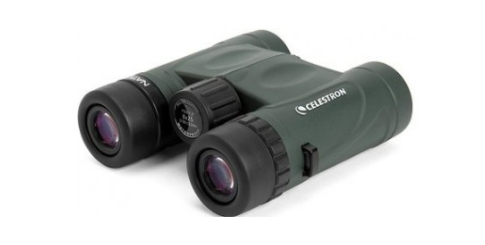 Magnification: 8x
Magnification: 8x
Objective lens: 32mm
Weight: 18oz / 516g
Field of view: 388ft
Pros: Affordable, easy to pack, provide the best image among budget binoculars, prevent fogging, protected from impact and wear.
Cons: Sticky rubber coating, the image can be a bit unrefined, there are lighter models available with similar features.
Price on B&H: $125 – View Product Here
Price on Amazon: $157 – View Product Here
Vortex Diamondback HD 8×28
If you are on a tight budget but don’t want to sacrifice quality and performance these binoculars will fulfill your expectations.
Their construction is sturdy and robust, and yet they weigh in at just 14 ounces. Vortex Diamondbacks are designed to endure rough field conditions. Rubber armor provides external protection.
They are waterproof and fog proof and also resistant to dust and other debris due to the O-ring seals.
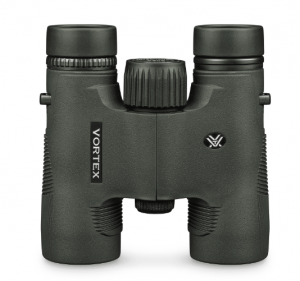
Impressive optical quality includes HD glass, added phase-corrective and a new prism. All these features make Diamondback perform like higher-class binoculars.
They are a great option for birders and backpackers.
They come with a lifetime warranty, which is a great bonus.
Magnification: 8x
Objective lens: 28mm
Weight: 14oz / 397g
Field of view: 332ft
Pros: Small and lightweight, multiple anti-reflective coatings, a scratch-resistant coating on exterior lenses, diopter adapts for differences in users’ eyes, shockproof, eyeglass-friendly.
Cons: The only downside is that gathering enough light in darker settings can be challenging. They are not the best option for early dawn and late dusk.
Price on B&H: $160 – View Product on B&H
Price on Amazon: $115 – View Product on Amazon
Nocs Provisions 8×25 Standard Issue Waterproof Binoculars
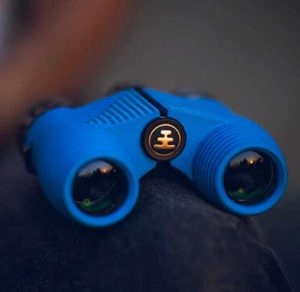 These binoculars are on the more affordable end of binoculars, but they have an extremely solid construction, is made from incredibly durable materials, and optics of higher grade than nearly any other binocular set of this price range.
These binoculars are on the more affordable end of binoculars, but they have an extremely solid construction, is made from incredibly durable materials, and optics of higher grade than nearly any other binocular set of this price range.
The compact size, mixed with waterproofing, great optics, an affordable price, and the ability to purchase in multiple zooms and colors make this one of the best choices out there.
Magnification: 8x or 10x
Objective lens: 25mm
Weight: 336g, 11.85oz
Field of view:
8x – 357ft @ 1000yds, 119M @ 1000M (6.8º)
10x – 315ft @1000yds, 105M @ 1000M (6.0º)
Pros: Extremely durable, great compact design, great optic quality for value.
Cons: Will want to upgrade to the Nocs Pro for better low light performance.
Price: $95 – View Product on Nocs | View On REI
Zeiss 8×25 Terra ED Compact Binoculars
Even when facing adverse weather and extreme conditions, these binoculars are a reliable companion. They are waterproof and come with multi-coated optics.
Since you never know when an exciting scene is about to emerge, having your binoculars at hand is the way to go. This particular model comes pocket-sized and yet performs like full-sized binoculars.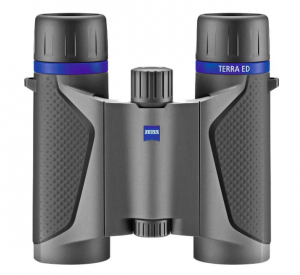
Optical precision and special Zeiss T coating guarantee magnificent, high-contrast images whether it is twilight or the light conditions are less than perfect.
With the folding design and just 11 ounces, transporting Zeiss Terra is as easy as it can be.
The focus wheel is perfectly positioned for the index finger, making this piece of gear convenient and easy to use.
This pair of binoculars is suitable for a variety of uses, like bird watching, traveling, nature observation and outdoor activities overall.
Magnification: 8x
Object lens: 25mm
Weight: 11oz / 310g
Field of view: 390ft
Pros: Ergonomic design, ideal for harsh conditions, sharp images and great precision, light and sturdy design.
Cons: They are on the pricier side.
Price on B&H: $379.99 – View Product on B&H
Price on Amazon: $349.99 – View Product on Amazon
Leica BCR Ultravid 8×20 compact binoculars
With less than 4 inches in length and just 9 ounces of weight, Leica’s Ultravid is one of the best pocket binoculars. Sturdy and robust, they can fit almost anywhere.
When it comes to the optics, these ultra-light and ultra-small binoculars are superbly sharp and remarkably bright (potentially the best optics in the compact category). They are also eyeglass friendly.
Whether you are off to observe birds or butterflies up close, Leica Ultravid will provide you with the clearest and most beautiful images possible. 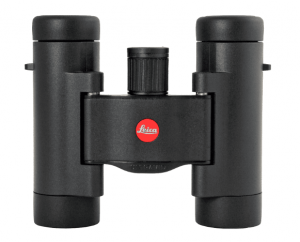
They come with many high-end features like quick focus wheel, adjustable eye caps, and inert gas internal filling. Unsurprisingly, beautiful engineering and superior optics come with a higher price tag.
Magnification: 8x
Object lens: 20mm
Weight: 8.5oz / 240g
Field of view: 341ft
Pros: Waterproof, fog proof, shock-absorbing rubber exterior, top-notch quality engineering.
Cons: Short field of view.
Price On B&H: $849 – View Product On B&H
Price on Amazon: $740 – View Product On Amazon
Nikon Trailblazer 8×25 ATB Waterproof Binoculars
If you are looking for lightweight construction, durability and a clear image you can’t go wrong with Nikon Trailblazer.
Nikon has used premium materials like lead- and arsenic-free Eco-Glass to make these binoculars. A rubberized armor coating provides a non-slip grip and shock resistance.
If you are enthusiastic about bird watching or exploring small animals, a wide field of views in Trailblazers makes them perfect for those purposes.
Even when the conditions are low multi-coated lenses will provide sharper, clear images.
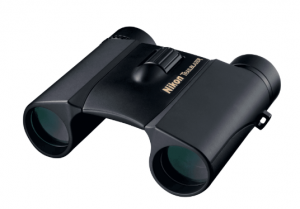
Due to the compact size and minor weight you can easily keep them in a small backpack or even in your jacket pocket. Nikon Trailblazers are fully waterproof, fog-proof and come with an affordable price tag that fits any budget – under $100.
Magnification: 8x
Object lens: 25mm
Weight: 19oz / 538g
Field of view: 429ft
Pros: Slim and ergonomic design, portability, weather-resistant, fast range of focus when you need quick viewing.
Cons: Subject to shake, so images can be shaky from time to time, lens caps are easy to lose.
Price on Amazon: $79 – View Product On Amazon | View On REI | View On B&H
Athlon Optics Midas
 The Athlon Optics Midas binoculars are on the larger end of hiking binoculars we suggest. If you are looking for clarity, a bit better low light performance, and superb waterproofing, these binoculars are a great option. The ED glass coating helps bring in more contrast and clarity. The increased size helps allow more light for those looking to be utilizing near sunrise, sunset, or in well shaded areas.
The Athlon Optics Midas binoculars are on the larger end of hiking binoculars we suggest. If you are looking for clarity, a bit better low light performance, and superb waterproofing, these binoculars are a great option. The ED glass coating helps bring in more contrast and clarity. The increased size helps allow more light for those looking to be utilizing near sunrise, sunset, or in well shaded areas.
The dielectric coating in each prism reflects 99% of light, making these binoculars perform very well at low light times, and the waterproofing is fantastic on these binoculars.
Magnification: 8x (10x option available)
Object lens: 42mm
Weight: 23.3 oz / 660.54 grams
Field of view: 426 ft
Pros: Waterproof, ED glass, ESP Dielectric Coating
Cons: Heavier than other top hiking binoculars
Price on Amazon: $269 – View Product On Amazon
An active outdoor lifestyle requires compact and durable binoculars with quality optics. When making a decision to buy binoculars for hiking there is a number of things to take into account.
Larger binoculars are also bulkier and heavier, although they offer higher quality images. The smaller size and lighter weight are more convenient options on the trails, so make sure to assess all features, size and weight for each binocular before making the purchase.
How To Choose Hiking Binoculars
The above binoculars are fantastic options, but there is some additional information worth knowing while doing your additional research. Compact binoculars are often wanted when hiking, so taking a look at roof vs porro prism
Types Of Binoculars For Hiking
Porro Prism: Porro prism is the classic look of binoculars where the body is angled, and the lenses “step out” from eye pieces.
Roof Prism: This style have straight tubes from the eyepiece to the lens. This style is often lightweight and more compact. Because these are lightweight and compact, roof prism tends to be the best type of binocular for hiking.
Roof Prism Vs Porro Prism:
| Porro Prism | Roof Prism | |
|---|---|---|
| Weight | Often heavier weight when compared to same quality | Often lighter weight when compared to same quality |
| Cost | Generally less expensive when compared to same quality | Generally more expensive when compared to same quality |
| Size | Often larger size when compared to same quality | Often smaller size when compared to same quality |
What Magnification Do I Need For Hiking?
With regards to magnifications, you should keep the below chart in mind. Hikers will often go with binoculars with lower magnification are often used by hikers that want closer looks at surrounding mountains and geography. Hikers that are more interested in birds or animals will elect for slightly higher magnification. You can read about birding or animal binoculars here.
An 8x magnification is probably the most common hiking binocular magnification.
| Lower Magnification | Higher Magnification | |
|---|---|---|
| Brightness | The lower the magnification, the brighter your image is | More magnification leads to darker images |
| Focus | The closer an object can be that your binoculars can focus on | The farther an object can be that your binoculars can focus on |
| Depth Of Field | Greater depth of field | Lesser depth of field |
| Size | Tends to be smaller sized binoculars | Tends to be larger sized binoculars |
| Ease Of Use | Generally easier to hold steady | Zoomed in, small movements in hands become easy to see. Heavier binoculars are often harder to hold still. |
Max DesMarais is the founder of hikingandfishing.com. He has a passion for the outdoors and making outdoor education and adventure more accessible. Max is a published author for various outdoor adventure, travel, and marketing websites. He is an experienced hiker, backpacker, fly fisherman, backcountry skier, trail runner, and spends his free time in the outdoors. These adventures allow him to test gear, learn new skills, and experience new places so that he can educate others. Max grew up hiking all around New Hampshire and New England. He became obsessed with the New Hampshire mountains, and the NH 48, where he guided hikes and trail runs in the White Mountains. Since moving out west, Max has continued climbed all of the Colorado 14ers, is always testing gear, learning skills, gaining experience, and building his endurance for outdoor sports. You can read more about his experience here: hikingandfishing/about

![The Best Binoculars for Hiking [And How To Choose] Best Hiking Binoculars](https://hikingandfishing.com/wp-content/uploads/2020/02/Best-Hiking-Binoculars.jpg)